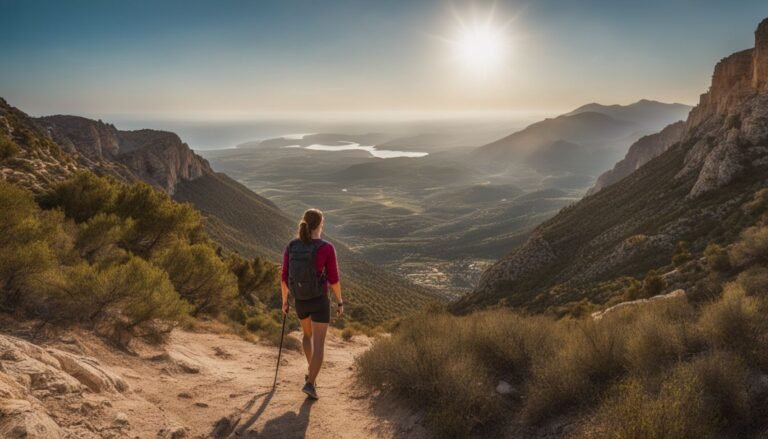Geological Formations And Sites Of Costa Blanca
Many people are curious about the natural beauty and history of Costa Blanca but don’t know where to start. This region is not only a popular vacation spot; it also boasts a rich geological heritage.
Our article will guide you through the fascinating geological formations and sites you can explore in Costa Blanca. Get ready for an exciting journey through time!
Key Takeaways
- Alicante Province displays rock formations over 200 million years old, including limestone caves and sandstone structures which give insights into Earth’s dynamic history. These formations tell stories of ancient marine environments and the effects of tectonic movements.
- Costa Blanca’s geology is unique due to significant geological events like the Messinian Salinity Crisis and the formation of the Betic Mountain Range. These events have shaped a diverse landscape that includes carbonate rocks dating back to the Triassic period.
- The Canelobre Caves offer an opportunity to see stalactites, stalagmites, and fossil deposits up close, providing a glimpse into millions of years of geological activity. Similarly, La Cova Tallada highlights how tectonic shifts have sculpted fascinating cave systems throughout Costa Blanca.
- Cucales Canyon stands out for its varied rock formations from different geological periods, presenting a rich natural heritage formed by rift systems and sediment contributions during the Mesozoic era.
- The Iberian Peninsula has played a crucial role in shaping Costa Blanca’s geology with its rich diversity of rocks from all major geological periods. This explains why areas like Elche hold UNESCO World Heritage sites based not only on cultural significance but also on their deep-rooted geological features.
Overview of Costa Blanca’s Geology

The geological canvas of Costa Blanca narrates a tale over 200 million years in the making, unfolding through epochs from the Triassic period to present day. This vast timeline has sculpted a landscape where sedimentary rocks from ancient marine environments nestle alongside metamorphic formations, revealing stories of earth’s dynamic processes.
The region epitomizes the geological diversity of the Mediterranean Sea shores, showcasing limestone cliffs that rise dramatically from azure waters and marlstone layers that hint at past sedimentary basins.
This diverse geology not only delineates the physical beauty of Costa Blanca but also reflects significant events like the opening of the Atlantic Ocean around 180 million years ago and subsequent formation phases leading to today’s Betic Mountain Range.
Such profound history underpins every rocky outcrop and sandy beach, providing an intricate backdrop against which both nature and culture have flourished. Transitioning from this overarching view into specific examples illuminates how these formations create unique attractions across Alicante Province.
Exploring Costa Blanca’s Geological Formations

Explore the unique rock formations of Alicante Province, showcasing the geological marvels of Costa Blanca. Discover the unparalleled beauty and diversity within Costa Blanca’s geology, offering an enriching experience for all enthusiasts.
The Rock Formations of Alicante Province
The Alicante province showcases rock formations that are a testament to over 200 million years of geological activity. These striking features have come into being through the combined forces of tectonic movements, volcanic eruptions, and erosive processes.
They paint a vivid picture of the Earth’s dynamic history, offering insights into periods ranging from the late Miocene to more recent times. Unique structures stand as markers of past environments, from ancient seabeds uplifted by tectonic shifts to limestone caves carved out by water over millennia.
Visitors to this region can witness firsthand the diversity in rock types like sandstones and limestones, each telling its own story about conditions on Earth when they were formed.
Metamorphic rocks reveal evidence of intense heat and pressure that reshaped them deep within the Earth’s crust before they were exposed on the surface. Together with deposits left behind by marine sediments and evaporites, these formations offer a rich tapestry illustrating significant chapters in our planet’s geological history.
Uniqueness of Costa Blanca’s Geology
Costa Blanca’s geology stands out because of its complex history and diverse landscape, shaped by forces that date back millions of years. This region witnessed significant geological events such as the Messinian Salinity Crisis and the folding and faulting from tectonic movements that led to the formation of the Betic Mountain Range.
These processes contributed to creating a rich tapestry of carbonate rocks dating back to the Triassic period, which today enhance Costa Blanca’s allure.
Marine terraces along the coast unveil stories of ancient sea levels while providing evidence for the Flandrian transgression, highlighting how rising seas during interglacial periods sculpted Alicante’s current relief.
Alternating cold glacial and warm interglacial periods further influenced sea level fluctuations throughout the Pleistocene, leaving behind a landscape ripe for discovery. This blend of dynamic geological changes makes Costa Blanca’s geology unique on both a regional scale within southern Spain and a broader context across the Mediterranean Basin.
Amazing Caverns and Caves of Costa Blanca
Explore the breathtaking underground wonders awaiting you in Costa Blanca, from the awe-inspiring Canelobre Caves to the mystical depths of La Cova Tallada. Discover the hidden gems and geological marvels that lie beneath the surface, each with its own fascinating story to tell.
Canelobre Caves
The Canelobre Caves are a testament to the geological history of Costa Blanca, showcasing stunning stalactites and stalagmites formed over millions of years. These caves feature various sandstone formations from different time periods, providing a unique opportunity to witness the region’s diverse geological past.
With rich fossil deposits, the caves offer insights into the marine life that existed in this area millions of years ago.
Dating back to different periods of time, these caves stand as living records of ancient geological processes and events. The magnificent formations within the Canelobre Caves display the remarkable diversity and richness of Costa Blanca’s geological heritage, making them an essential destination for those interested in exploring the region’s fascinating natural history.
La Cova Tallada
Transitioning from the enchanting Canelobre Caves to La Cova Tallada, we explore another remarkable geological formation in the Alicante province. La Cova Tallada is emblematic of the diverse geology that characterizes this region.
Shaped by tectonic movements and geological transformations over time, this cave stands as a testament to the dynamic forces at play in shaping Costa Blanca’s landscape.
La Cova Tallada beckons adventurers and nature enthusiasts who are drawn to its captivating natural allure. A popular choice for budget-conscious travelers, this site offers an abundance of geological wonders waiting to be explored.
Tunel del Castillo
The Tunel del Castillo is a part of the network of amazing caverns and caves found in Costa Blanca, providing a glimpse into the geological formations of the region. These underground spaces showcase carbonate rocks, limestone, and dolomite formed during the Triassic period, contributing to the unique geological makeup associated with the Tunel del Castillo and other related caves.
The shaping of these formations is attributed to tectonic movements and the subsiding of the Tethys basin, offering a fascinating insight into Costa Blanca’s captivating geology.
Cueva de las Aranas
Moving from the striking formations of Tunel del Castillo, we come to another geological wonder in Costa Blanca – Cueva de las Aranas. This cave holds its own significance among the top caverns and caves of the region.
Its association with specific geological formations or processes unique to Costa Blanca makes it a significant site for those interested in the area’s geology.
Cueva de las Aranas ranks as one of the top 5 caves in Costa Blanca and is indeed an essential stop for anyone looking to explore the remarkable geological features within this region.
Cova de las Finestres
The Cova de las Finestres is an integral part of the amazing caverns and caves in Costa Blanca. This site features unique geological formations and sites, adding to the diverse geology of the region.
The cave’s intriguing features make it a must-visit for those interested in exploring the geological wonders of Costa Blanca.
Let’s now delve into “Experiencing the Spectacular Rock Formations of Cucales Canyon.”
Experiencing the Spectacular Rock Formations of Cucales Canyon
Cucales Canyon offers a breathtaking display of rock formations that date back to various geological periods. The area features sandstone formations from different sources, providing a unique and diverse experience for visitors.
During the Mesozoic period, rift systems and sediments contributed to the stunning geological features of Cucales Canyon, showcasing its rich history and natural beauty.
The Late Stephanian period played a pivotal role in shaping the zone into its current crescent shape, forming an orocline. Visitors are treated to various units with distinct rock formations that add to the beauty and intrigue of Cucales Canyon.
This makes it an ideal destination for those seeking an immersive experience in Costa Blanca’s mesmerizing geological wonders.
Geological Significance of the Iberian Peninsula
After exploring the spectacular rock formations of Cucales Canyon, it’s essential to appreciate the geological significance of the Iberian Peninsula. The region boasts a rich and diverse geological history, encompassing rocks from every geological period from the Ediacaran to the Quaternary era.
At its core lies the Hercynian cratonic block known as the Iberian Massif, with the Cantabrian Zone holding unmetamorphosed Paleozoic rocks. Over millions of years, movements of the Iberian Plate have led to various mountain ranges and structures being formed, making it an invaluable area for studying Earth’s geological evolution.
The Iberian Peninsula has witnessed significant periods such as Permian and Mesozoic eras, each contributing to its intricate geological tapestry. This unique geology provides a platform for understanding ancient tectonic activities and environmental changes that have shaped our planet over time.
Costa Blanca’s World Heritage Sites
Costa Blanca boasts a rich cultural and historical heritage, with several sites designated as UNESCO World Heritage. These sites include El Palmeral in Elche, the Mediterranean diet, cave art, and the mystery of Elche, each offering a unique glimpse into the region’s remarkable past.
El palmeral (Elche)
El palmeral in Elche, dating back to the 8th century, stands as one of the largest palm groves worldwide. Established during the Muslim era in Spain, it served as a vital source of agricultural and economic prosperity.
Reflecting advanced engineering and water management techniques, the irrigation system within the palm grove is a testament to Muslim civilization’s ingenuity. Recognized as a UNESCO World Heritage Site for its historical and cultural significance, local farmers continue to maintain and preserve this treasured site, ensuring its enduring cultural and environmental value.
The Mediterranean diet
The Mediterranean diet, deeply rooted in the geological formations and sites of Costa Blanca, is a cultural treasure that emphasizes fresh fruits, vegetables, whole grains, and healthy fats.
Encompassing a balanced lifestyle built on locally-sourced ingredients and traditional cooking methods, this diet has been linked to numerous health benefits. Rich in olive oil and seafood – supplied by the coastal region’s diverse geological features – it offers a nutritional approach associated with reduced risks of heart disease diabetes and other chronic conditions.
Its alignment with the unique landscape of Costa Blanca underscores its significance not only as a dietary choice but also as an embodiment of sustainable living within the region’s geological context.
Cave art
Cave art in Costa Blanca is closely linked to its World Heritage Sites, showcasing the cultural and historical significance of the region’s geological formations. The caves have served as canvases for prehistoric paintings and carvings, offering a window into the ancient societies that once thrived here.
These artistic expressions provide valuable insights into the beliefs, rituals, and daily lives of early inhabitants, enriching our understanding of their cultures. Additionally, through cave art, visitors can gain a deeper appreciation for the unique combination of geological marvels and human history present in Costa Blanca.
Next up: “The mystery of Elche (Elche)”
The mystery of Elche (Elche)
Elche, located in the West Asturian Leonese Zone, holds a geological mystery within its Cambrian and Ordovician rocks. This enigmatic city is intertwined with the intriguing Ossa-Morena Zone, which underwent significant transformation through faulting with the Central Iberian Zone during the late Langsettian and early Duckmantian stages of the Carboniferous period.
Such geological complexities have fascinated researchers, unveiling a wealth of mysteries waiting to be unlocked.
The historical significance of Elche’s geological formations offers an opportunity for enthusiasts to delve into a realm where ancient rock layers tell captivating stories from centuries past.
Geological Field Guide to Costa Blanca
Discovering the geological wonders of Costa Blanca provides a unique opportunity to witness the impact of tectonic movements and natural forces over millions of years. From the Betic Mountain Range in southern Spain, formed due to tectonic movement, to the transformation of sedimentary rocks into metamorphic rocks in Sierra de Orihuela and Callosa de Segura, the region’s geology offers a captivating insight into Earth’s history.
The collision of the Meso Mediterranean block and Iberia approximately 19-20 million years ago resulted in the formation of Cordillera Betica, showcasing the profound influence of geological processes on shaping this picturesque coastal area.
Embracing this field guide is an invitation to explore not only spectacular rock formations but also gain a deeper understanding of how these landscapes were shaped by past environmental events.
By delving into Costa Blanca’s geological heritage, visitors can uncover fascinating insights about its distinctive landforms while admiring stunning natural beauty at every turn.
Walking Experiences in Costa Blanca
Explore the breathtaking Rock of Ifach, offering an exhilarating climb with stunning views. Embark on the Orihuela Costa Route for leisurely strolls along picturesque trails.
Climbing the Rock of Ifach
Climbing the Rock of Ifach provides a thrilling adventure, offering breathtaking views from its 332-meter summit. The rock, formed during the Betic Orogeny, beckons climbers with its rugged beauty and challenging ascent.
As you climb, you’ll witness diverse flora and fauna typical of this limestone outcrop.
The experience is heightened by spotting rare plant species that thrive in this seemingly inhospitable environment. From the top, take in panoramic vistas encompassing the Mediterranean coastline and surrounding landscapes—making it an ideal destination for both nature enthusiasts and adventure seekers alike.
Orihuela Costa Route
Transitioning from the adventurous climb of the Rock of Ifach, the Orihuela Costa Route offers a captivating journey through the geological wonders of Costa Blanca. This walking experience provides an opportunity to delve into the diverse and unique geological formations that define this enchanting region.
As you explore this route, you will encounter fascinating rock formations while gaining a deeper appreciation for the geological diversity that makes Costa Blanca truly remarkable.
The Orihuela Costa Route presents a perfect opportunity for nature enthusiasts and geology aficionados to immerse themselves in the breathtaking landscapes shaped by millions of years of geological evolution within Costa Blanca.
Conclusion
Uncover the geological wonders of Costa Blanca, a destination brimming with unique rock formations and stunning caves. From the mesmerizing Canelobre Caves to the breathtaking Cucales Canyon, there’s an adventure waiting at every turn.
Dive into the depths of history and witness the captivating geological significance of the Iberian Peninsula while exploring world heritage sites such as El palmeral in Elche. Embark on a fascinating journey through Costa Blanca’s diverse landscapes and delve into its rich geological history for an experience like no other.
FAQs
1. What makes the geological formations of Costa Blanca unique?
Costa Blanca’s geology is fascinating due to its variety, from the abyssal plains and underwater valleys like the Valencia Trough to ancient rock zones such as Ossa Morena Zone and Galicia-Trás-os-Montes Zone. This area showcases a rich tapestry of Earth’s history, including events like the Zanclean flood and features formed during the Pyrenean orogeny.
2. How did Costa Blanca’s landscape form?
The landscape of Costa Blanca was shaped over millions of years by processes like rifting, which split continents apart, and subduction, where one tectonic plate moves under another. These actions created features such as the Betic Range and contributed to phenomena like the Messinian Salinity Crisis that dramatically changed sea levels.
3. Can you find any evidence of ancient oceans in Costa Blanca?
Yes! The geological record in areas like the Balearic Abyssal Plain and Ebro Basin contains sediments that tell stories of ancient seas. Coral Patch Seamounts and cherts are remnants of deep-sea environments, while layers of clastics reveal periods when shallow coastal shelves were more common.
4. What types of rocks can be found in Costa Blanca?
In Costa Blanca, you’ll discover a wide range of rocks that speak volumes about Earth’s dynamic past. From basement rocks formed early in our planet’s history to metamorphosed rocks showing signs of intense heat and pressure changes over time. There are also fascinating examples of migmatite – mixed rock indicating partial melting.
5. How does studying Costa Blanca help us understand global geological events?
Studying this region offers clues into major global events such as continental drift from Gondwana splitting or insights into anoxic events that drastically affected marine life conditions worldwide. The area’s diverse geology provides evidence for significant shifts like those seen during Devonian age or Ordovician period climatic changes.
6. Are there any notable geological sites related to volcanic activity on Costa Blanca?
While not predominantly known for recent volcanic activity compared to other regions, historical traces can still be found around places close by such as Canary Islands’ peridotite formations or even further back with mid-oceanic ridge interactions shaping nearby landmasses centuries ago.







